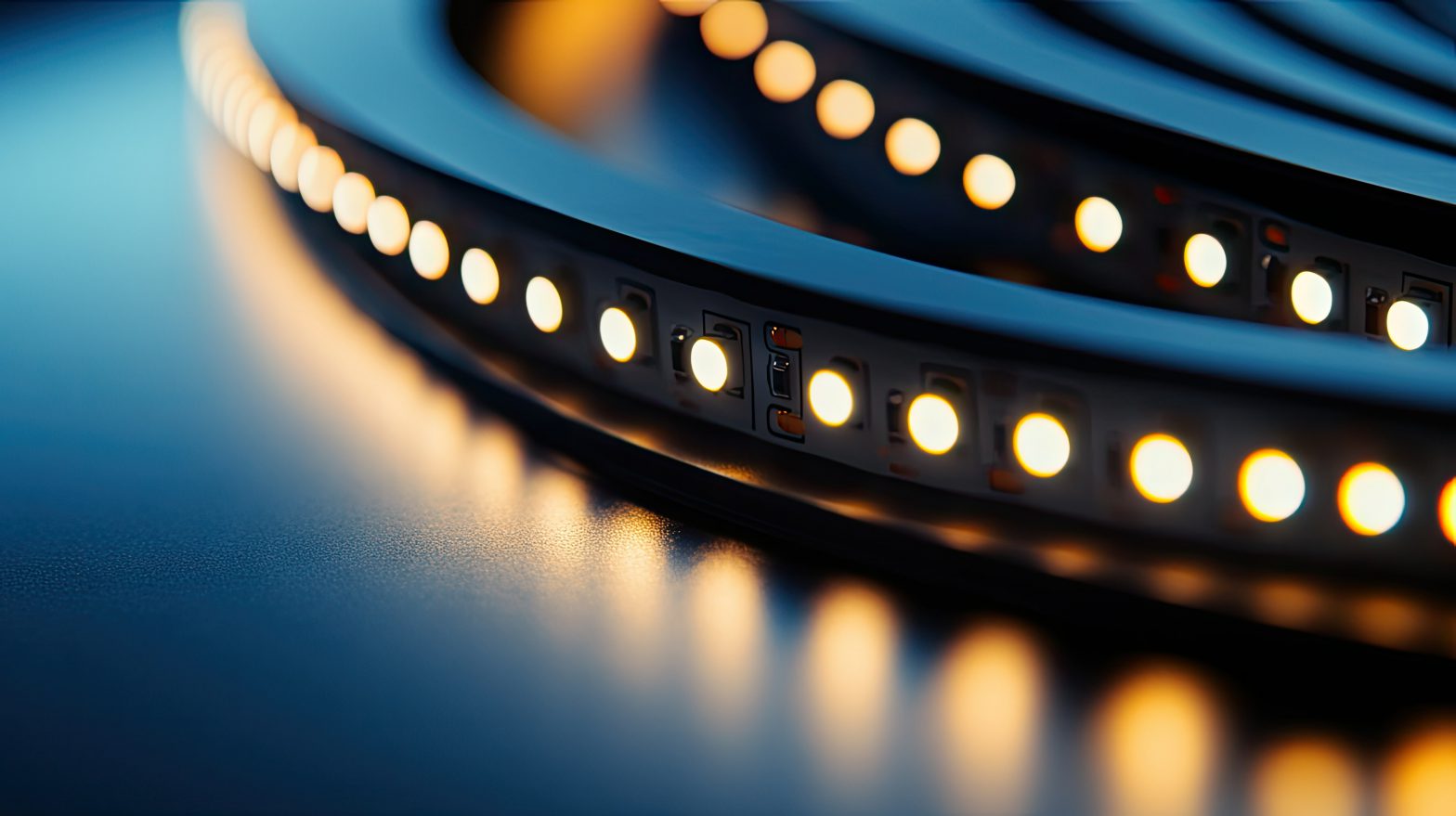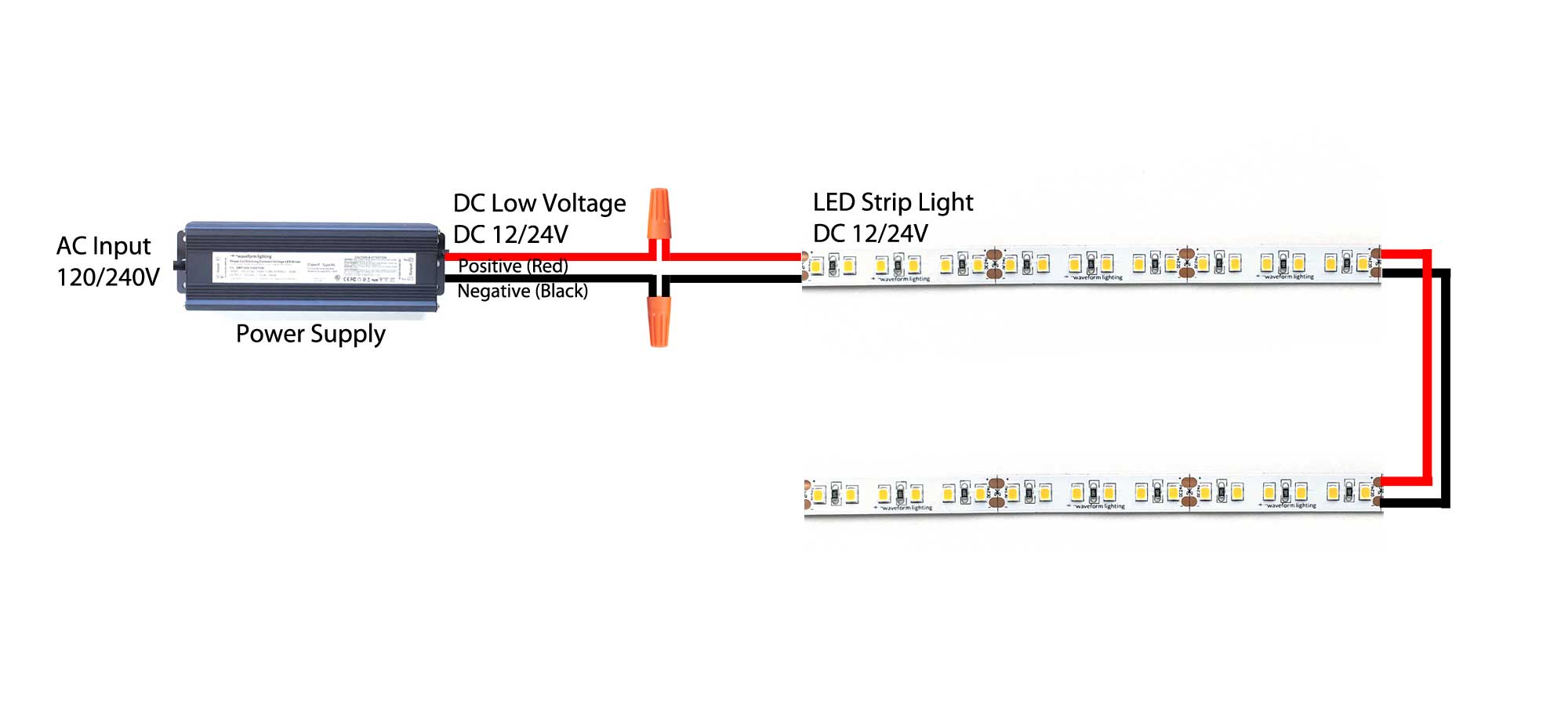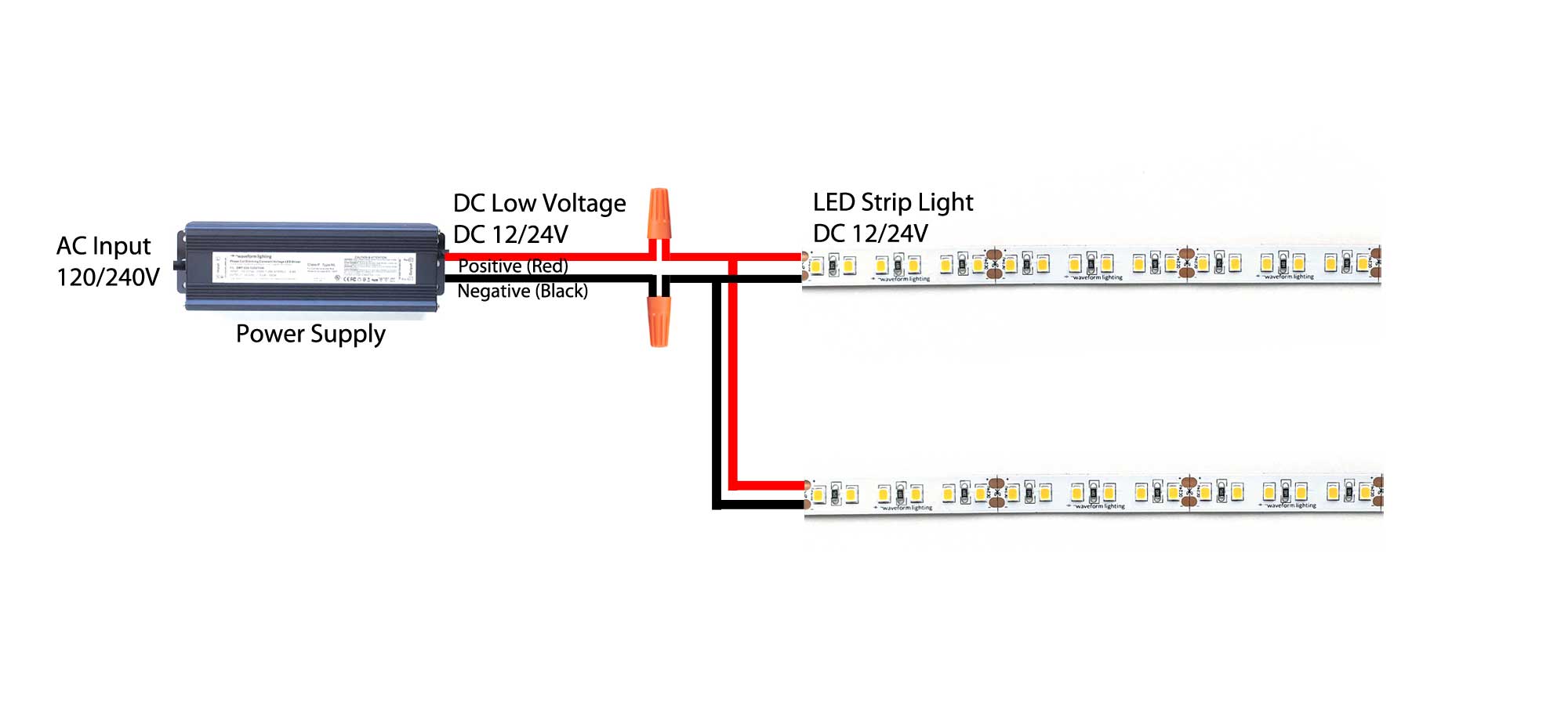
Connecting LED Strips in "Series" vs "Parallel"
You've decided to use LED strip lights for your next project, or you may even be at the point where you're ready to wire everything up. If you have more than one run of LED strip, and you're trying to connect them to a single power source, you might be wondering: should they be connected in series or in parallel?
The LED strips come with markings that show you which side to connect the positive, and which side to connect the negative (ground) wire, so it's quite straightforward when you just need to connect one LED segment to the corresponding power supply wires of the same color. If you have two or more LED strip sections and you're wondering how you should connect them together, read on to learn more about how whether to connect LED strip lights in "series" or "parallel"!
Disclaimer: the terms "series" and "parallel" are technically incorrect from an electronics perspective! We use these terms in this article for simplicity, but put them in quotations for accuracy. Please read the end of the article for a comprehensive explanation.
How To Connect LED Strips In "Series"
The idea behind connecting two LED strip sections in "series" is probably the most logical and straightforward method. You can think of it as simply joining one end of an LED strip to the next LED strip section. If you just need to span a short distance, you might find some solderless connectors handy, or you can even span a longer distance with copper wires cut to the exact length you need. For longer runs, you'll want to watch for voltage drop, but otherwise, all you really need to do is to produce an electrical connection between the positive/negative copper pads from one LED strip section to another

This is a quick and easy method, because it doesn't require you to create another separate wire connection to the power supply. You're simply allowing for a "jump" between two LED strip sections.
The downside is that this creates the potential for additional voltage drop, leading to diminished light output among the LEDs furthest from the power supply. The reason is that connecting the LED strips in "series" allows for only one path for the electrical current to take. All of the electrical current for an entire LED strip installation needs to travel through the first few inches of the LED strip run, which can act as a bottle neck for current flow, reducing the amount of voltage and current that reaches the farther LED strip sections.
How To Connect LED Strips in "Parallel"
The alternative to connecting multiple LED strip sections together is to wire them in "parallel." This method involves creating independent runs of LED strip sections, each of which are wired directly to the power source.

As you can see in the diagram, this reduces the amount of current that needs to pass through any given LED strip section, because they are wired directly to the power source. This can help significantly in reducing the potential for voltage drop.
The main disadvantage of this approach is that it will require a bit more wiring work. The main challenge is that most power supply units will only have one of each positive and negative output wires, so to connect that to more than one LED strip section will require you to split that output into multiple wires. Specialized wire splitter terminal blocks are available for this purpose.
Another difficulty is that some LED strip sections may be located far away from the power supply. In these cases, you may find not only an added expense with long wire runs, but that they need to be of sufficient gauge. Otherwise, you may end up with voltage drop in the wires before you even reach the LED strip section.
Why "Series" and "Parallel" are Technically Incorrect
Many customers use the word "series" to describe connecting multiple LED strip sections end-to-end, or daisy-chaining. Some of our more observant readers, however, may have noticed that we put the word "series" in quotes. The reason is that technically speaking, the term "series" is incorrect when referring to this configuration.
Why is it incorrect, and why is this important? This has to do with the way LED strip lights are designed and their corresponding electronics principles. LED strips are long and come in a series (in the non-engineering sense, as in "one after the other"), but in reality they are made up of many parallel branches, comprised of 3 LEDs each for LED strips rated at 12V (or 6 LEDs each in a 24V LED strip).
In other words, the 3 LEDs are connected in series, but the groups of 3 LEDs are connected to one another in parallel. This is what allows us to simply cut the LED strip lights in intervals of 3 LEDs. If you cut an LED strip, you're simply reducing the number of branches that are connected in parallel. When you connect an LED strip in an end-to-end configruation (daisy-chain), you're simply adding back additional parallel branches.
We find it is important to clarify, because true electrical series connections will change the required input voltage. When people talk about wiring LED strips in "series," however, they almost always connecting LED strip sections end-to-end. When connected in this way, the LED strip input voltage remains unchanged. In other words, you can use a 12V power supply to power a 4-ft section of 12V LED strip lights with another 3-ft section of 12V LED strip lights daisy-chained.
The LED strips come with markings that show you which side to connect the positive, and which side to connect the negative (ground) wire, so it's quite straightforward when you just need to connect one LED segment to the corresponding power supply wires of the same color. If you have two or more LED strip sections and you're wondering how you should connect them together, read on to learn more about how whether to connect LED strip lights in "series" or "parallel"!
Disclaimer: the terms "series" and "parallel" are technically incorrect from an electronics perspective! We use these terms in this article for simplicity, but put them in quotations for accuracy. Please read the end of the article for a comprehensive explanation.
How To Connect LED Strips In "Series"
The idea behind connecting two LED strip sections in "series" is probably the most logical and straightforward method. You can think of it as simply joining one end of an LED strip to the next LED strip section. If you just need to span a short distance, you might find some solderless connectors handy, or you can even span a longer distance with copper wires cut to the exact length you need. For longer runs, you'll want to watch for voltage drop, but otherwise, all you really need to do is to produce an electrical connection between the positive/negative copper pads from one LED strip section to another

This is a quick and easy method, because it doesn't require you to create another separate wire connection to the power supply. You're simply allowing for a "jump" between two LED strip sections.
The downside is that this creates the potential for additional voltage drop, leading to diminished light output among the LEDs furthest from the power supply. The reason is that connecting the LED strips in "series" allows for only one path for the electrical current to take. All of the electrical current for an entire LED strip installation needs to travel through the first few inches of the LED strip run, which can act as a bottle neck for current flow, reducing the amount of voltage and current that reaches the farther LED strip sections.
How To Connect LED Strips in "Parallel"
The alternative to connecting multiple LED strip sections together is to wire them in "parallel." This method involves creating independent runs of LED strip sections, each of which are wired directly to the power source.

As you can see in the diagram, this reduces the amount of current that needs to pass through any given LED strip section, because they are wired directly to the power source. This can help significantly in reducing the potential for voltage drop.
The main disadvantage of this approach is that it will require a bit more wiring work. The main challenge is that most power supply units will only have one of each positive and negative output wires, so to connect that to more than one LED strip section will require you to split that output into multiple wires. Specialized wire splitter terminal blocks are available for this purpose.
Another difficulty is that some LED strip sections may be located far away from the power supply. In these cases, you may find not only an added expense with long wire runs, but that they need to be of sufficient gauge. Otherwise, you may end up with voltage drop in the wires before you even reach the LED strip section.
Why "Series" and "Parallel" are Technically Incorrect
Many customers use the word "series" to describe connecting multiple LED strip sections end-to-end, or daisy-chaining. Some of our more observant readers, however, may have noticed that we put the word "series" in quotes. The reason is that technically speaking, the term "series" is incorrect when referring to this configuration.
Why is it incorrect, and why is this important? This has to do with the way LED strip lights are designed and their corresponding electronics principles. LED strips are long and come in a series (in the non-engineering sense, as in "one after the other"), but in reality they are made up of many parallel branches, comprised of 3 LEDs each for LED strips rated at 12V (or 6 LEDs each in a 24V LED strip).
In other words, the 3 LEDs are connected in series, but the groups of 3 LEDs are connected to one another in parallel. This is what allows us to simply cut the LED strip lights in intervals of 3 LEDs. If you cut an LED strip, you're simply reducing the number of branches that are connected in parallel. When you connect an LED strip in an end-to-end configruation (daisy-chain), you're simply adding back additional parallel branches.
We find it is important to clarify, because true electrical series connections will change the required input voltage. When people talk about wiring LED strips in "series," however, they almost always connecting LED strip sections end-to-end. When connected in this way, the LED strip input voltage remains unchanged. In other words, you can use a 12V power supply to power a 4-ft section of 12V LED strip lights with another 3-ft section of 12V LED strip lights daisy-chained.
Other Posts
Browse Waveform Lighting Products
A-Series LED Bulbs
Our A19 and A21 lamps fit in standard lamp fixtures and are perfect for floor and desk lamp fixtures.
Candelabra LED Bulbs
Our candelabra LED bulbs offer soft and warm light output in a decorative bulb style that fits E12 lamp fixtures.
BR30 LED Lamps
BR30 lamps are ceiling lamps that fit in residential and commercial fixtures with 4-inch or wider openings.
